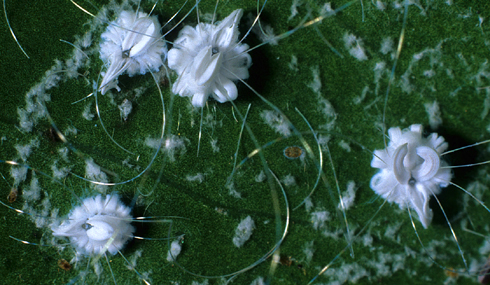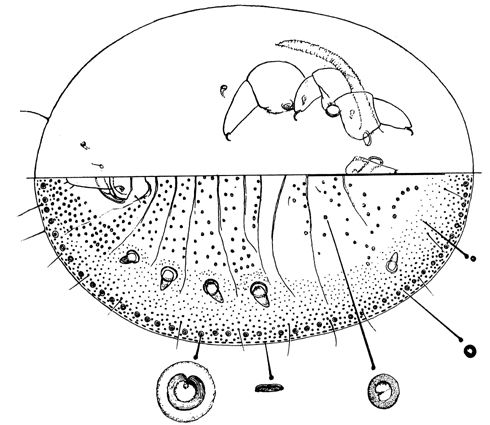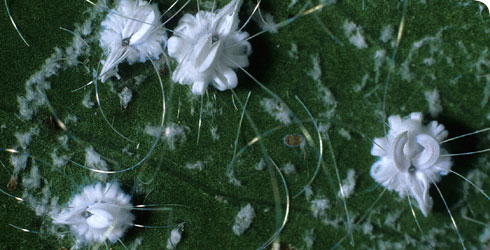Aleurodicus dispersus (spiralling whitefly)
The spiralling whitefly (Aleurodicus dispersus) is a major pest devouring agricultural crops as it spreads with extraordinary speed across the tropics.
Spiralling whitefly is not a fly but a true bug, a member of the order Hemiptera who all feed on liquid food via stylets, modified tubular mouthparts.
Species detail

Moth-like adults in waxy secretions on a leaf. © J Martin
Adult whiteflies resemble tiny moths, with four wings covered by a white dusting of mealy material that resembles the wing scales in butterflies and moths.
The common name spiralling whitefly arises from the adult females laying eggs in spirals of waxy material.
All whiteflies are phytophagous and the spiralling whitefly is highly polyphagous, feeding on many plant species, in many plant families. The polyphagy of the spiralling whitefly is the major reason it is able to spread so quickly from one crop to another across the tropics.
-

Habitat and distribution
The distributional history of Aleurodicus dispersus is one of the most interesting factors about the insect. Learn about the spread of Aleurodicus dispersus from the 1950s to the present.
-

Biology
Read about the strange life cycle of the spiralling whitefly.
-

Pest management
Conservation of the spiralling whitefly is not high on the agenda. Find out about the management efforts in place to control this pesty insect and read why it is a good example of failed quarantine procedures.
-

References
Find further reading material for Aleurodicus dispersus.
Images

Four puparia of spiralling whitefly, having developed in undisturbed conditions, display their highly characteristic waxy secretions which can allow positive identification without recourse to a microscope. Santa Cruz de Tenerife, Canary Islands.
© J Martin
Photomicrograph of a single puparium of Aleurodicus dispersus in lateral view, showing curls and filaments of waxy secretions.
© J Martin
A moth-like Aleurodicus dispersus adult amongst waxy secretions on a leaf surface. Esmeraldas, Ecuador.
© J Martin
Egg-laying waxy spirals left by ovipositing female of an Aleurodicus species, Bermuda.
© Sam Fraser-Smith
Line drawing, by Arthur Cushman, that accompanied the original description of the puparium of Aleurodicus dispersus.
About the author
Dr Jon Martin
Former Curator of Hemiptera, Department of Entomology.
Author comments
The spiralling whitefly has been chosen because of
- its impressive ability to cause problems as a major pest of agricultural crops
- the quite extraordinary speed with which it has conquered almost all warmer parts of the world, probably facilitated by mankind’s addiction to trade and travel
- its spectacular ability to completely cover the lower surfaces of every leaf on a plant and, in exceptional cases, to kill it's host
- its beauty at the final nymphal stage of development when viewed microscopically
Glossary
Polyphagy
The ability of insect species to feed on a variety of plant species from many plant families.
